2013 Peugeot 508 RXH check engine
[x] Cancel search: check enginePage 5 of 308

.
.
Contents
Child seats 162
ISOFIX child seats 168
Child lock 171
Child safety
Direction indicators 172
Emergency or assistance call 173
Horn 173
ESC system 174
Seat belts 177
Airbags 180
Safety
Te m p o r a ry puncture
repair kit 184
Changing a wheel 190
Snow chains 195
Changing a bulb 196
Changing a fuse 203
12 V battery 207
Energy economy mode 210
Changing a wiper blade 211
Recovering the vehicle 212
Vehicle recovery 214
Towing a trailer 215
Fitting roof bars 217
Very cold climate screen 217
Accessories 218
Practical information
Opening the bonnet 221
Running out of fuel (Diesel) 222
Diesel engine 223
Checking levels 224
Checks 227
Checks
Electric motor 230
Diesel engine 231
Diesel weights 232
Dimensions 233
Identifi cation markings 234
Technical data
Emergency or assistance 235
JBL equipment 237
Peugeot Connect Navigation (RT6) 239
Audio equipment and telematics
Alphabetical index
Visual search
Page 7 of 308

.
5
Familiarisation
For economical driving, caring for the environment
The fuel consumptionof a vehicle varies greatly:
- according to the driver's style of driving
(moderate, aggressive, fast, ...),
- according to the type of journeys
made (urban, main road, motorway, flowing, heavy traffic, …) and the speed.
Main recommendations for driving economically
Hybrid mode selector
To optimise fuel consumption, use the Automodeof the selector whenever possible (the mode is activated
automatically when starting) including for urban journeys.
This mode optimises the use of the energy sources (internal combustion engine and/or electric) contrary to other modes, which are for use in par ticular cases.
Gear lever
Use the automatic
mode A
as much as possible as this optimises gear changes to suit the requirements.
Drive smoothly
Stay in the "eco" zone
displayed in the energy consumption / generation indicator: accelerate gently, drive atsteady speeds using the speed limiter or cruise control as soon as possible. Use the "charge" zone: anticipate the need to slow down by taking your foot off the accelerator rather than
braking. The movement of the energy consumption / generation indicator needle (into the "charge" zone), shows
the level of energy recovery.
Consumption history
See the impact of your style of driving and the type of journey by reviewing the history of your energyconsumption. Refer to the "Multifunction screens" section.
Causes of high consumption and checks
As with any vehicle, limit overloading, wind resistance (windows open above 30 mph (50 km/h), roof rack, loaded
or not, …), the use of power consumers (air conditioning, heated seats, heated rear screen, …).
Obser ve the recommendations on checks (regular check of tyre pressures, correct tyre pressures, …) and routine servicing.
Page 31 of 308
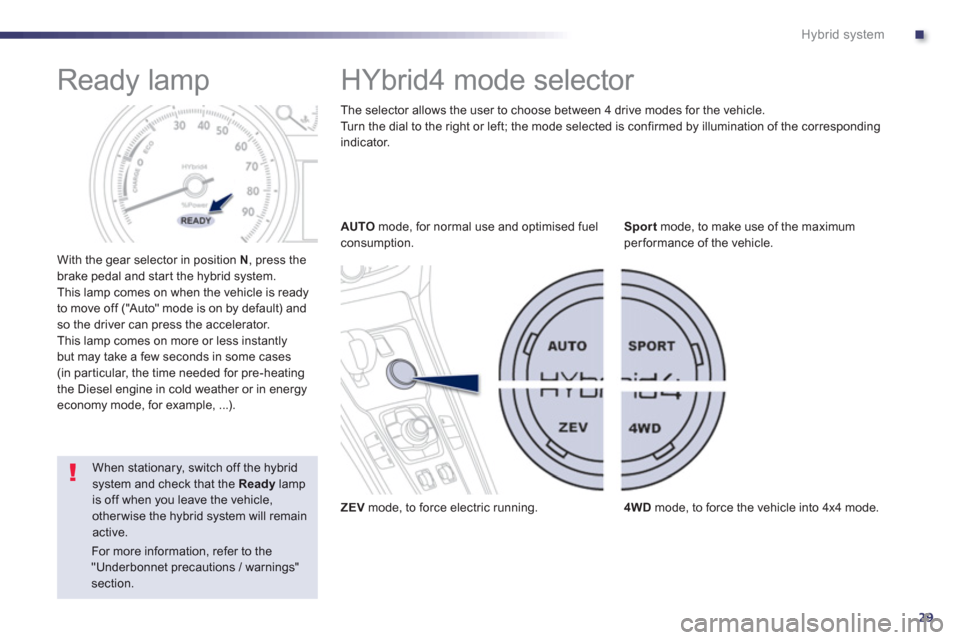
.
29
Hybrid system
Ready lamp
With the gear selector in position N, press the
brake pedal and star t the hybrid system.
This lamp comes on when the vehicle is read
y
to move off ("Auto" mode is on by default) andso the driver can press the accelerator.
This lamp comes on more or less instantlybut may take a few seconds in some cases (in par ticular, the time needed for pre-heating
the Diesel engine in cold weather or in energy economy mode, for example, ...).
HYbrid4 mode selector
AUTOmode, for normal use and optimised fuelconsumption.
ZEVmode, to force electric running.S
portmode, to make use of the maximum
performance of the vehicle.
4WDmode, to force the vehicle into 4x4 mode.
When stationary, switch off the hybridsystem and check that the Readylamp is off when you leave the vehicle,otherwise the hybrid system will remainactive. Th
e selector allows the user to choose between 4 drive modes for the vehicle.
Turn the dial to the right or left; the mode selected is confirmed by illumination of the corresponding indicator.
For more information, refer to the "Underbonnet precautions / warnings" section.
Page 43 of 308
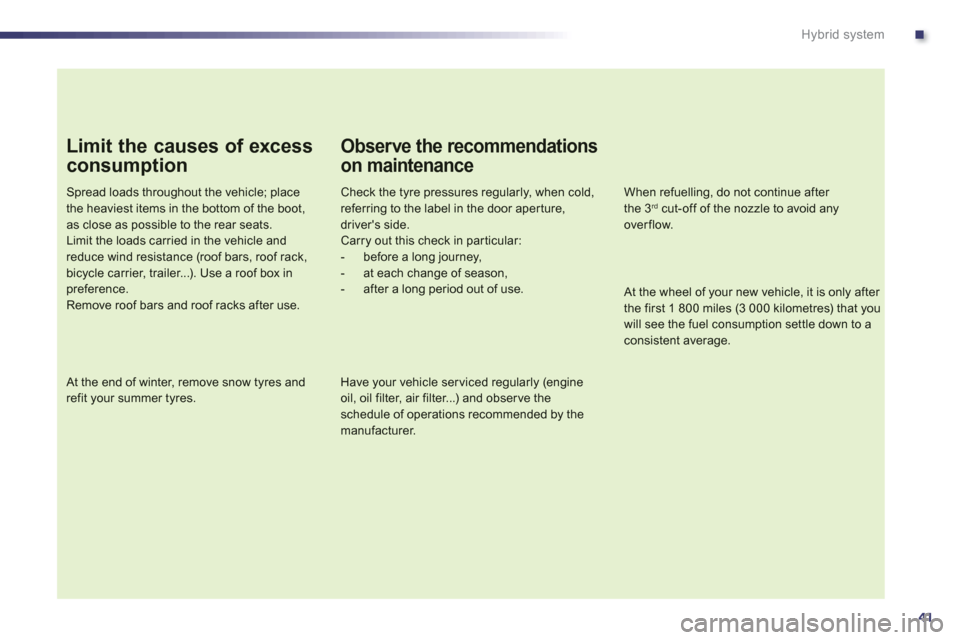
.
41
Hybrid system
Limit the causes of excess
consumption
Spread loads throughout the vehicle; placethe heaviest items in the bottom of the boot,
as close as possible to the rear seats.Limit the loads carried in the vehicle and reduce wind resistance (roof bars, roof rack, bicycle carrier, trailer...). Use a roof box inpreference.Remove roof bars and roof racks after use.
At the end of winter, remove snow tyres and refit your summer tyres.
Observe the recommendations
on maintenance
Check the tyre pressures regularly, when cold, referring to the label in the door aper ture, driver's side.Carry out this check in par ticular:- before a long journey,- at each change of season,- after a long period out of use.
When refuelling, do not continue after the 3rdcut-off of the nozzle to avoid any overflow.
Have your vehicle ser viced regularly (engine oil, oil filter, air filter...) and obser ve the schedule of operations recommended by the
manufacturer.
At the wheel of your new vehicle, it is only after the first 1 800 miles (3 000 kilometres) that youwill see the fuel consumption settle down to aconsistent average.
Page 49 of 308
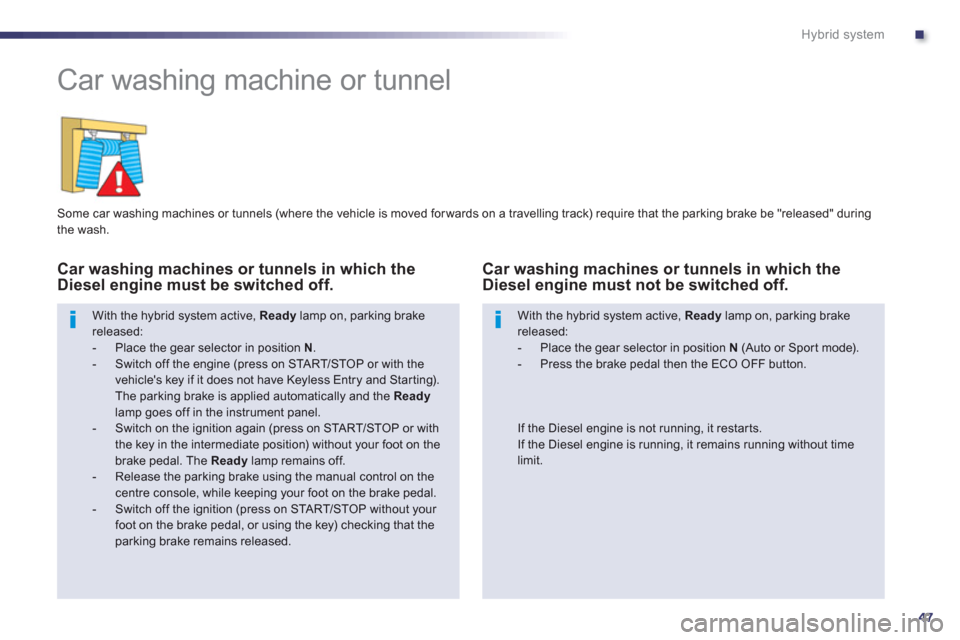
.
47
Hybrid system
Car washing machine or tunnel
Some car washing machines or tunnels (where the vehicle is moved for wards on a travelling track) require that the parking brake be "released" during
th
e wash.
Car washing machines or tunnels in which theDiesel engine must be switched off.
With the hybrid system active, Readylamp on, parking brakereleased:- Place the gear selector in position N.- Switch off the engine (press on STA R T/STOP or with thevehicle's key if it does not have Keyless Entry and Starting).The parking brake is applied automatically and the Readylamp goes off in the instrument panel.- Switch on the ignition again (press on START/STOP or with
the key in the intermediate position) without your foot on the brake pedal. The Readylamp remains off. - Release the parking brake using the manual control on the centre console, while keeping your foot on the brake pedal.- Switch off the ignition (press on STA R T/STOP without your foot on the brake pedal, or using the key) checking that the parking brake remains released.
With the hybrid system active, Ready
lamp on, parking brake released:
- Place the gear selector in position N
(Auto or Sport mode).
- Press the brake pedal then the ECO OFF button.
Car washing machines or tunnels in which the Diesel engine must not be switched off.
If the Diesel engine is not running, it restar ts.
If the Diesel engine is running, it remains running without time limit.
Page 59 of 308
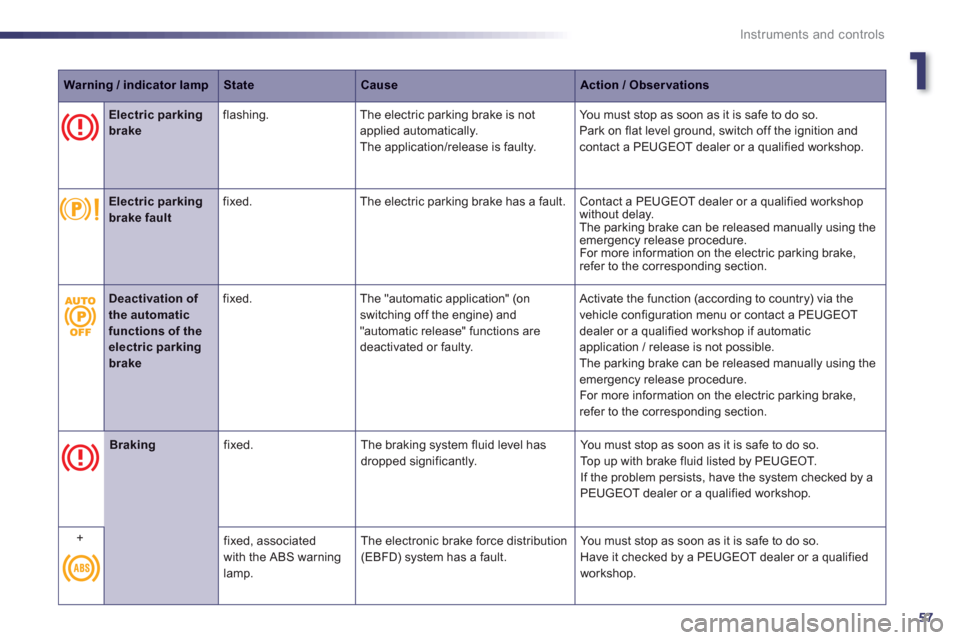
1
57
Instruments and controls
Warning / indicator lampStateCauseAction / Observations
Electric parkingbrakeflashing. The electric parking brake is not
applied automatically.
The application/release is faulty. You must stop as soon as it is safe to do so.
Park on flat level ground, switch off the ignition andcontact a PEUGEOT dealer or a qualified workshop.
Electric parkingbrake faultfixed. The electric parking brake has a fault. Contact a PEUGEOT dealer or a qualified workshop without delay.
The parking brake can be released manually using theemergency release procedure.
For more information on the electric parking brake,refer to the corresponding section.
Braking
fixed. The braking system fluid level has
dropped significantly. You must stop as soon as it is safe to do so.
Top up with brake fluid listed by PEUGEOT.
If the problem persists, have the system checked by a
PEUGEOT dealer or a qualified workshop.
+
fixed, associated
with the ABS warninglamp. Th
e electronic brake force distribution(EBFD) system has a fault. You must stop as soon as it is safe to do so.
Have it checked by a PEUGEOT dealer or a qualified
workshop.
Deactivation of the automaticfunctions of theelectric parking brake
fixed. The "automatic application" (onswitching off the engine) and "automatic release" functions are
deactivated or faulty. Activate the
function (according to country) via the
vehicle configuration menu or contact a PEUGEOT
dealer or a qualified workshop if automatic
application / release is not possible.
The parking brake can be released manually using theemergency release procedure.
For more information on the electric parking brake,refer to the corresponding section.
Page 60 of 308
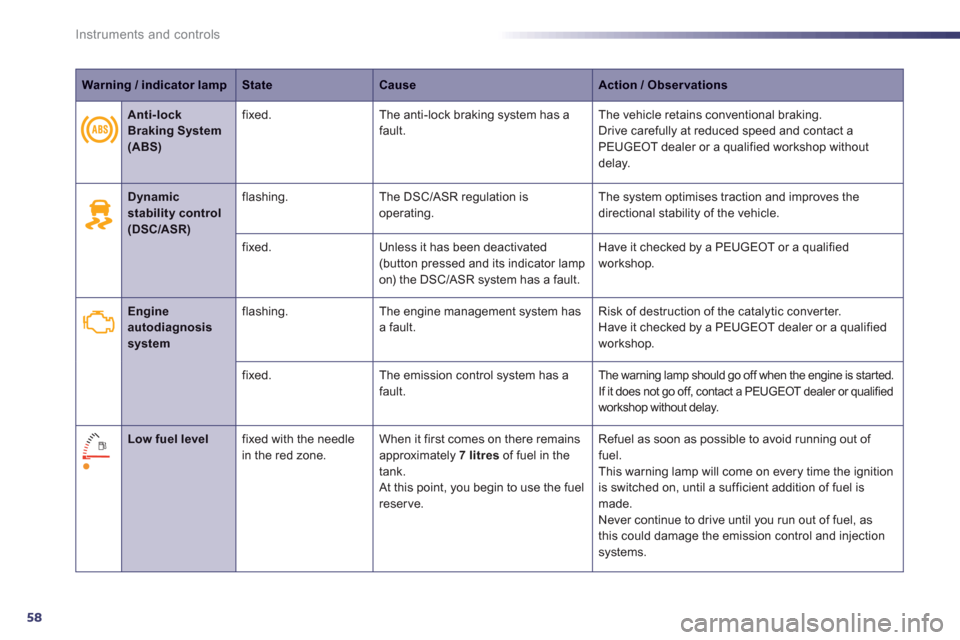
58
Instruments and controls
Warning / indicator lampStateCauseAction / Observations
Dynamic stability control(DSC/ASR)
flashing. The DSC/ASR regulation is
operating. The system optimises traction and improves the
directional stability of the vehicle.
fixed. Unless it has been deactivated(button pressed and its indicator lamp
on) the DSC/ASR system has a fault.Have it checked b
y a PEUGEOT or a qualified
workshop.
Engine autodiagnosis system
flashing.The engine management system hasa fault. Risk of destruction of the catalytic conver ter.
Have it checked by a PEUGEOT dealer or a qualified
workshop.
fixed.The emission control system has afault. The warning lamp should go off when the engine is started.
If it does not go off, contact a PEUGEOT dealer or qualified
workshop without delay.
Low fuel levelfixed with the needle
in the red zone. When it first comes on there remainsapproximately 7 litresof fuel in the
tank.
At this point, you begin to use the fuel reserve.Refuel as soon as possible to avoid runnin
g out of
fuel.This warning lamp will come on every time the ignition
is switched on, until a sufficient addition of fuel is made.
Never continue to drive until you run out of fuel, as
this could damage the emission control and injectionsystems.
Anti-lockBraking System(ABS)
fixed. The anti-lock braking system has a
fault. The vehicle retains conventional braking.
Drive carefully at reduced speed and contact a
PEUGEOT dealer or a qualified workshop without
dela
y.
Page 62 of 308
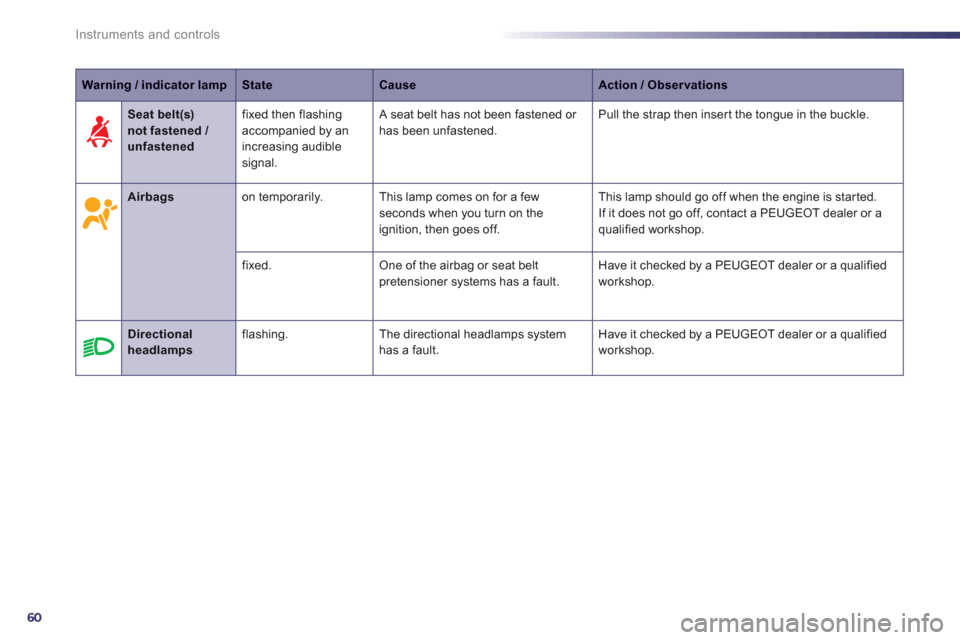
60
Instruments and controls
Warning / indicator lampStateCauseAction / Observations
Airbagson temporarily. This lamp comes on for a fewseconds when you turn on the
ignition, then goes off. This lamp should
go off when the engine is started.
If it does not go off, contact a PEUGEOT dealer or a
qualified workshop.
fixed.One of the airbag or seat beltpretensioner systems has a fault.Have it checked by a PEUGEOT dealer or a qualified
workshop.
Directionalheadlampsflashing. The directional headlamps systemhas a fault.Have it checked by a PEUGEOT dealer or a qualified
workshop.
Seat belt(s) not fastened / unfastenedfixed then flashin
gaccompanied by anincreasing audible
signal. A
seat belt has not been fastened or has been unfastened.Pull the strap then inser t the tongue in the buckle.